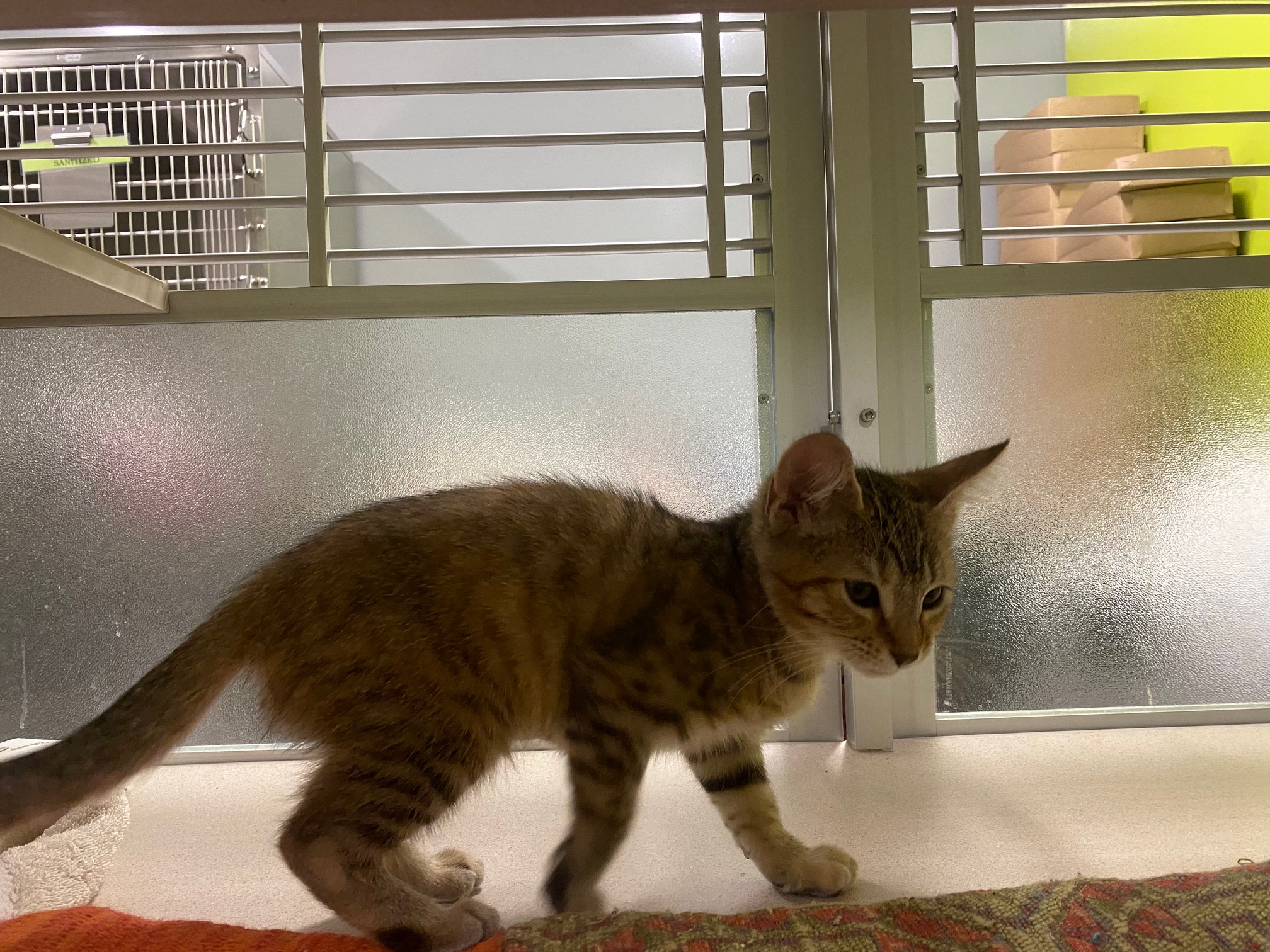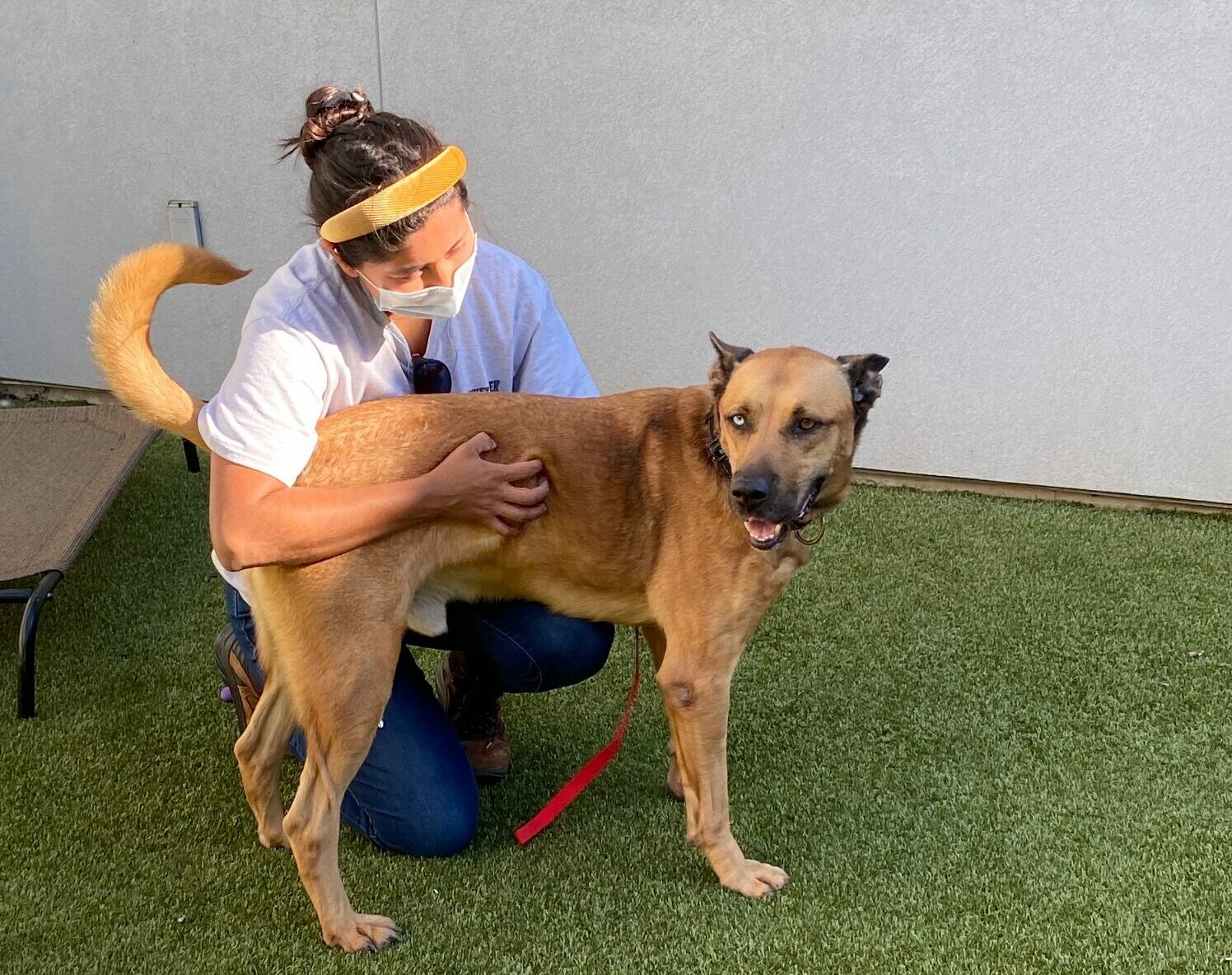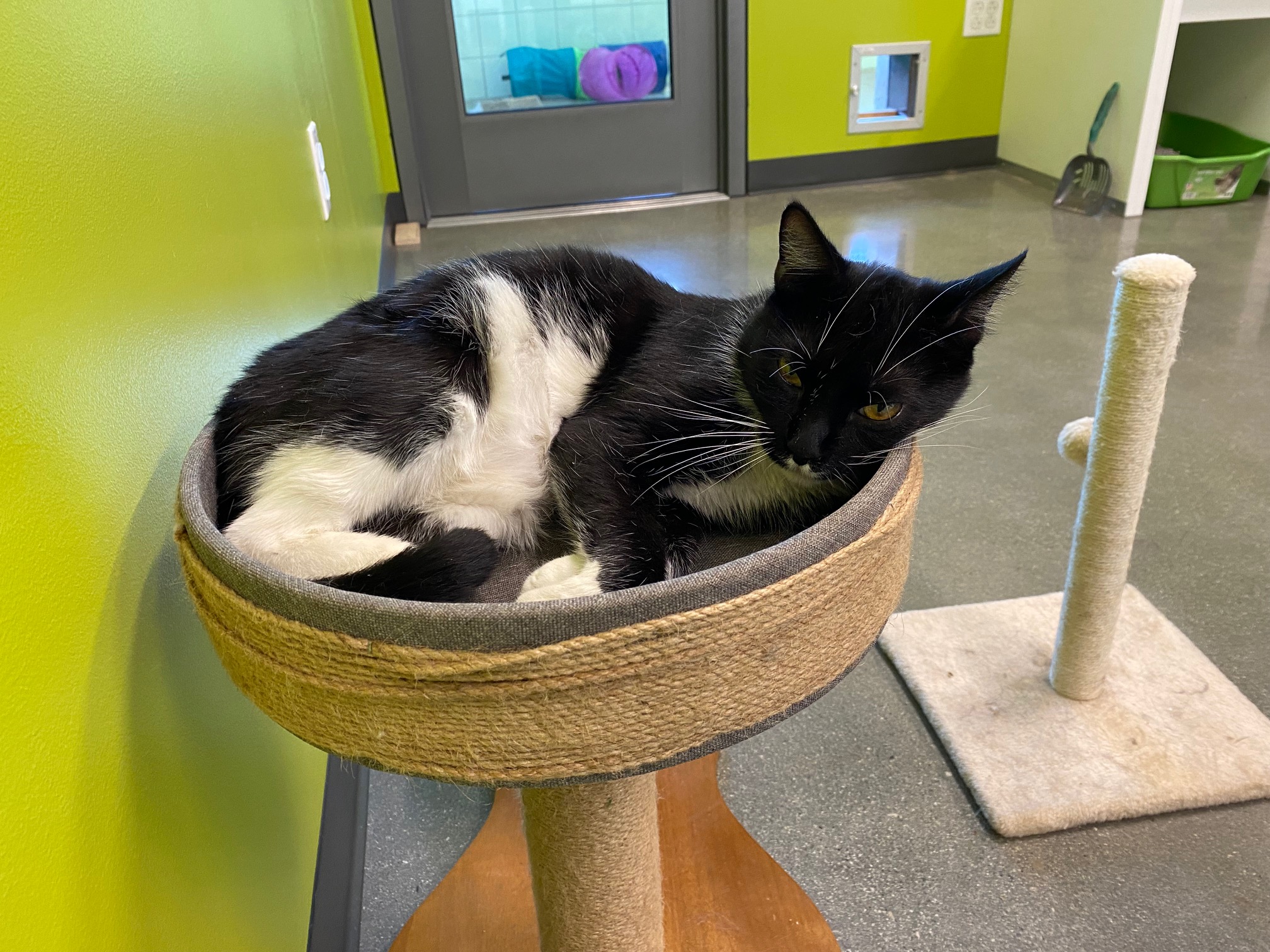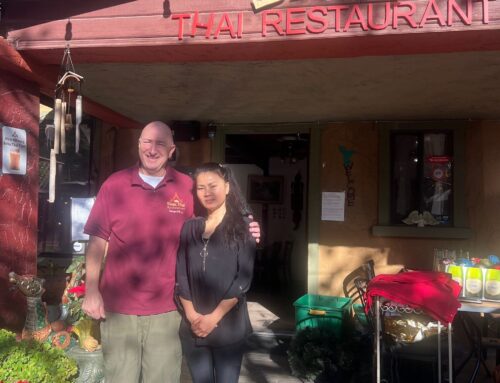Nearly full, the shelter needs foster parents and volunteers to help
![]()

Nova and Alex Vega, an operations aide responsible for dog programs, get some exercise in the yard at the San Martin Animal Shelter. Photo by Nolan Lyle
By Nolan Lyle

Nolan Lyle
Duke is a shepherd-husky mix who has been living at the San Martin Animal Shelter for six months while waiting patiently for a home. He’s a good dog, a little aloof to strangers, but well behaved in manners and curious and playful when let out in the exercise yard.
“I don’t know why he’s been here so long,” said Lisa Jenkins, the center’s manager. “He’s a little more on the rambunctious side, but nothing unworkable or terrible.”
Set on eight acres south of San Martin, the $35-million facility is open seven days a week and can care for up to 8,000 animals a year. The 37,000-square-foot center opened in February 2021 and houses domestic animals including livestock. Stray cats and dogs are primarily the pets its staff takes care of while waiting for a family or individual to bring to a new home. The shelter is always open to people who want to volunteer in some capacity.

Photo by Nolan Lyle
“One big need we have is for folks to help out with our large dog play groups,” Jenkins said. “That’s going to be a very specialized volunteer. It’s somebody who is physically capable, and very able to handle rambunctious larger dogs . . . Somebody with a really calm demeanor, who doesn’t get easily rattled.”
Volunteers don’t need special certification, and the shelter volunteer coordinator will provide training. One requirement is volunteers must be 18 years and older.

Photo by Nolan Lyle
Another way people can volunteer is by fostering dogs and cats at their homes to open space in shelter kennels. This often leads to a permanent home.
“It used to be called a ‘foster fail,’” Jenkins said. “I call it a ‘foster success.’ That’s a wonderful thing we offer. Not a lot of shelters will let you ‘test drive,’ and we know it’s a huge commitment to take on an adult dog with its own personality. If you’re not sure if you want to adopt you can always foster. And that’s a great way to see if it’s a good fit.”

Photo by Nolan Lyle
The shelter provides various services to help animals enjoy a higher quality of life. It offers free or low cost spay and neuter operations and will combine these with microchipping, vaccinations, and other options.
The largest percentage of the population the shelter takes in are underage, unweaned kittens, between 1,000 to 1,500, into foster care meaning they’re too young to be spayed and neutered and go up for adoption, she said.
“That’s a big chunk of our population. And it’s resource intensive,” she said. “Anytime you can get cats spayed or neutered, that frees up resources for us to use elsewhere.”

Photo by Nolan Lyle
Johanne DiQuattro loves volunteering at the shelter and is passionate about helping the animals.
“I really enjoy the hands-on aspect of socializing with the animals,” she said. “Coming into a shelter can be very stressful for animals. Socializing helps them adjust to their new surroundings.”
 Volunteers also provide them with enrichment, affection, and exercise, which increases their overall wellbeing and helps bring out their true personalities as well as increases their chances of being adopted, she said.
Volunteers also provide them with enrichment, affection, and exercise, which increases their overall wellbeing and helps bring out their true personalities as well as increases their chances of being adopted, she said.
“We get to know the animals’ personality and preferences by spending time with them,” she said. “This assists in providing information to potential adopters looking for particular qualities as well as helping find the animal a well-suited home.”
Volunteers assist the public with general information as well as serving as the liaison in the adoption process with shelter staff.
They carry the message educating the public regarding the utmost importance of spaying and neutering, which has the largest impact on helping to control pet overpopulation. They also provide the animals with general care such as grooming, feeding, providing fresh water, cleaning, and informing shelter staff of any issues that may require additional care.
 They also make sure the animals are in a pleasant environment by providing toys and comfortable bedding. They take and upload pictures, videos, and personality descriptions to post on the county’s website as well as other adoption sites. They assemble animal appropriate welcome home “goody” bags for the adopter that contain instructions, toys, food, and other items. Laundry is perpetual.
They also make sure the animals are in a pleasant environment by providing toys and comfortable bedding. They take and upload pictures, videos, and personality descriptions to post on the county’s website as well as other adoption sites. They assemble animal appropriate welcome home “goody” bags for the adopter that contain instructions, toys, food, and other items. Laundry is perpetual.
“I genuinely enjoy working with animals. They bring me joy and feed my soul,” DiQuattro said. “Science has proven being in the presence of animals provides humans several health benefits in which I can certainly attest to.”
Volunteering at the shelter is the Hollister woman’s way of giving back to the community by directly making an impact on improving the lives of animals and humans.
“I’m relatively new to the area, and volunteering has been a great way to meet those who live and work within our community,” she said.
 Santa Clara County Supervisor Mike Wasserman, who represents the South Valley, has been an animal lover his whole life. Ever since getting his first rescue animal in 1980 — a cat he and his wife, Kim, named “Schmoo” — he has wanted to do all he can for dogs and cats that needed homes.
Santa Clara County Supervisor Mike Wasserman, who represents the South Valley, has been an animal lover his whole life. Ever since getting his first rescue animal in 1980 — a cat he and his wife, Kim, named “Schmoo” — he has wanted to do all he can for dogs and cats that needed homes.
“Over the years we have rescued several dogs and cats — but I always wanted to do more,” he said. “When I got on the board of supervisors and saw the old shelter and that funding for something better was available, I decided this was the moment to make a dream come true for me and the animals.”
With a 95 percent live release rate, the center ranks on the top of public animal facilities in California. It is the only shelter in the Pacific Coast region to win the prestigious Rachael Ray No-Kill Excellence Grant award in 2020.
The new center is designed with the idea of being the hub of the community and inviting people in to see the animals and the work staff and volunteers do. The center features a large, flexible community meeting space with a capacity of up to 300 guests. They can walk into the lobby and view the canine animals in an open area park that’s shaded. The park is surrounded by glass, so people can stop and watch the dogs play — and hopefully fall in love and take a pet home.
 Creating a more natural and relaxed experience for cats, the center provides three rooms and an outside “catio” patio for feline pets to safely sun themselves. A spacious 2,500-square-foot barn holds 10 stalls to provide a comfortable shelter for livestock such as horses, goats, chickens and pigs to rehabilitate. Nearby is a large, fenced-in pasture area to house farm animals that are less socialized. The center is the only one in the region designed to handle livestock.
Creating a more natural and relaxed experience for cats, the center provides three rooms and an outside “catio” patio for feline pets to safely sun themselves. A spacious 2,500-square-foot barn holds 10 stalls to provide a comfortable shelter for livestock such as horses, goats, chickens and pigs to rehabilitate. Nearby is a large, fenced-in pasture area to house farm animals that are less socialized. The center is the only one in the region designed to handle livestock.
The San Martin Animal Shelter is spectacular in many ways: for the animals that come there and for the people who work and volunteer there, Wasserman said. It’s vital for the entire community to enjoy and use.
“Our new shelter is the finest in the nation and other counties should come visit and duplicate all we’ve done,” he said. “All animals deserve that!”
Nolan Lyle is an eighth grader at Charter School of Morgan Hill. He wrote this with the assistance of publisher Marty Cheek.






